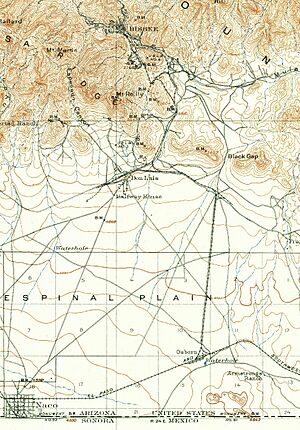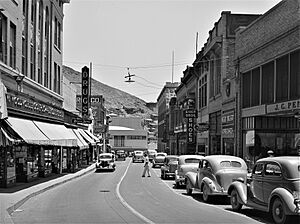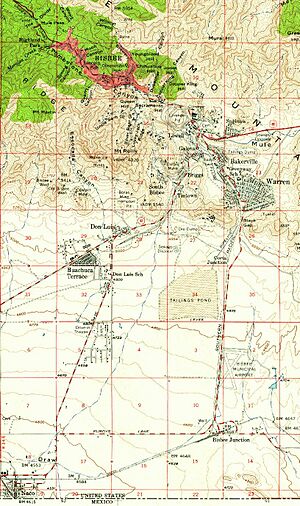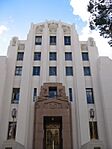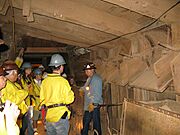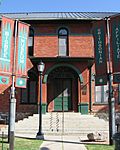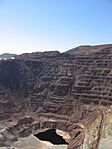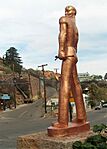Bisbee, Arizona facts for kids
Quick facts for kids
Bisbee, Arizona
|
||
|---|---|---|
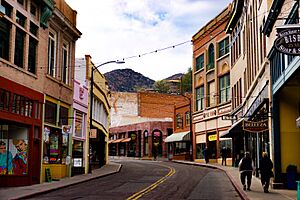
Main Street in Bisbee (2019)
|
||
|
||
| Motto(s):
"Queen of the Copper Camps”
|
||
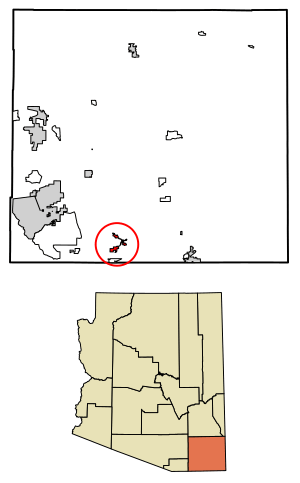
Location of Bisbee in Cochise County, Arizona
|
||
| Country | United States | |
| State | Arizona | |
| County | Cochise | |
| Incorporated | January 9, 1902 | |
| Government | ||
| • Type | Council-manager | |
| • Body | Bisbee City Council | |
| Area | ||
| • Total | 5.18 sq mi (13.41 km2) | |
| • Land | 5.18 sq mi (13.41 km2) | |
| • Water | 0.00 sq mi (0.00 km2) | |
| Elevation | 5,538 ft (1,688 m) | |
| Population
(2020)
|
||
| • Total | 4,923 | |
| • Density | 950.39/sq mi (367.11/km2) | |
| Time zone | UTC−07:00 (MST (no daylight saving time)) | |
| ZIP Code |
85603
|
|
| Area code | 520 | |
| FIPS code | 04-06260 | |
| GNIS feature ID | 1436 | |
| Website | City of Bisbee | |
Bisbee is a city in Cochise County, southeastern Arizona, United States. It is about 92 miles (148 km) southeast of Tucson and 11 miles (18 km) north of the Mexican border. In 2020, the city had a population of 4,923 people. Bisbee is also the county seat of Cochise County.
Contents
History of Bisbee
Bisbee was started as a mining town in 1880. It was named after Judge DeWitt Bisbee, who helped fund the nearby Copper Queen Mine. Miners dug for copper, gold, and silver here.
In 1919, an event called the Bisbee Riot happened in the town. Later, in 1929, Bisbee became the county seat, taking over from Tombstone. It has been the county seat ever since.
Mining in Bisbee
Mining in the Mule Mountains was very successful. In the early 1900s, many people moved to Bisbee. By 1910, its population grew to 9,019, making it the third-largest city in the area. It also had several smaller towns nearby, like Warren, Lowell, and San Jose. Some of these towns had their own mines.
In 1917, a new way of mining called open-pit mining was started. This helped meet the high demand for copper during World War I.
A special type of turquoise called Bisbee Blue was found here as a side product of copper mining. Many beautiful mineral samples from Bisbee mines are now in museums around the world. These include minerals like cuprite, aragonite, wulfenite, malachite, azurite, and galena.
The Bisbee Deportation

Miners tried to form groups to get better working conditions and pay. In 1917, the Phelps Dodge Corporation and local law enforcement gathered over 1,000 striking miners. They put them into cattle cars and sent them on a long journey through the desert to Hermanas, New Mexico. This happened because the company wanted to stop the miners from forming unions. The miners' group, the Industrial Workers of the World (IWW), wanted safer working conditions and fair treatment for all workers, whether they were from the U.S. or immigrants.
Mining Slows Down and Tourism Begins
Even as mining changed and other towns' mines closed, Bisbee kept going with its underground mines. However, Bisbee's population dropped a lot, from 9,205 in 1920 to 3,801 by 1950. In 1975, the Phelps Dodge Corporation stopped its copper mining in Bisbee.
To help the town's economy, Bisbee's Mayor Chuck Eads worked with Phelps Dodge to start a mine tour. They opened a part of the Copper Queen Mine for visitors. This was an effort to bring in heritage tourism and create new jobs.
Local volunteers worked hard to clear rocks and fix up the old mine tunnels. The U.S. government's Economic Development Administration noticed their efforts. They gave a large grant to Bisbee to help with the mine tour and improve downtown areas for tourists. The Queen Mine Tour officially opened on February 1, 1976. More than a million people have visited the underground mine tour since then.
Modern Bisbee Today
From 1950 to 1960, Bisbee's population grew again by almost 160 percent. This happened because open-pit mining started, and the city added nearby areas. The highest population was in 1960, with 9,914 people.
In the next ten years, jobs and population decreased, but not as much as before. Because of these economic changes, housing prices became very low. With its nice weather and beautiful scenery, Bisbee became a popular place in the 1960s for artists and people from the counterculture.
In 1970, artist Stephen Hutchison and his wife Marcia bought the Copper Queen Hotel. This hotel was a key business and a beautiful building in town. The mining company had tried to sell it for just $1, but no one local wanted it because it needed a lot of work.
Hutchison bought and fixed up the hotel, along with other old buildings downtown. He started to promote Bisbee as a real, old Southwest destination. His work attracted another developer, Ed Smart.
Many famous people stayed at the Copper Queen Hotel. Actor John Wayne often visited Bisbee and the hotel. He became friends with Hutchison and later worked with Smart on real estate projects. This time in Bisbee's history is written about in magazines like The New Yorker. Bisbee became a safe place for artists and people who found larger cities too expensive.
In the 1990s, more people moved to Bisbee. This led to new places like coffee shops and live theaters. Many old houses have been fixed up, and property values in Bisbee are now higher than in other cities in southeastern Arizona.
Today, the historic part of Bisbee is called "Old Bisbee." It has a lively downtown area with many cultural activities. The buildings are known for their beautiful architecture, including Victorian-style houses and an elegant Art Deco county courthouse. Old Bisbee is easy to walk around because it was designed before cars were common. The town is very hilly; for example, the old four-story high school has an entrance on the ground level for each floor!
Bisbee's Suburbs
The city of Bisbee now includes the nearby communities of Warren, Lowell, and San Jose. Lowell and Warren became part of Bisbee early in the 1900s. There are also smaller neighborhoods like Galena, Bakerville, Tintown, South Bisbee, Briggs, and Saginaw.
Warren was Arizona's first planned community. It was built for the wealthier people of the mining district to live in. Warren has many beautiful Arts and Crafts style bungalow houses. Many of these homes are now considered historic. The city even has an annual home tour where you can visit some of them. Since mining ended in the 1970s, Warren has seen some changes. However, it still has many residents and is home to City Hall, Greenway Elementary School, Bisbee High School, and the historic Warren Ballpark.
Lowell was once a large mining town southeast of Old Bisbee. Most of the original town was dug away to create the Lavender Pit mine in the 1950s. Today, only a small part of Erie Street remains, along with Evergreen Cemetery, the Saginaw area, and Lowell Middle School. Most local people now think of Lowell more as a place name than a busy community.
San Jose is on the southern side of the Mule Mountains. It is the newest part of the city. Because it is not surrounded by mountains, it has had the most new buildings since the late 1990s. It is named after a nearby Mexican mountain. San Jose is where many newer county government buildings, Huachuca Terrace Elementary School, and a large shopping center are located.
Mining Today
In 2007, Freeport-McMoRan Copper & Gold bought the Phelps-Dodge company. Freeport has helped Bisbee by cleaning up soil from past mining and by donating to the school system and other community activities.
Geography of Bisbee
Arizona State Route 80 goes through Bisbee. It leads northwest 23 miles (37 km) to Tombstone and 47 miles (76 km) to Benson. To the east, it goes 26 miles (42 km) to Douglas. The Mexican border at Naco is 11 miles (18 km) south of Bisbee's center.
The United States Census Bureau says the city covers a total area of 5.18 square miles (13.4 km2), all of it land.
The natural plants around Bisbee look like a semi-desert. You can see shrubby acacia and oak trees, along with cacti, grass, ocotillo, and yucca. The town itself has more lush plants, with large native trees like cypress, sycamore, and cottonwood. There are also introduced trees like ailanthus and Old World cypresses, cedars, and pines. Palms can grow tall here, but they are not always strong enough for the climate. You might even see a mature blue spruce tree.
Bisbee's Climate
Bisbee has a typical semi-arid climate (Köppen BSk) found in the high Mountain West. Summer days are warm to hot and dry. Then, the monsoon season brings the most rain from July to September. Bisbee gets about 10.65 inches (271 mm) of its total annual rainfall of 18.63 inches (473 mm) during this time, often with strong thunderstorms. In winter, weather fronts can bring rain or even snow. However, winter temperatures are usually very mild and sometimes even warm.
| Climate data for Bisbee, Arizona (1991–2020 normals, extremes 1985–2021) | |||||||||||||
|---|---|---|---|---|---|---|---|---|---|---|---|---|---|
| Month | Jan | Feb | Mar | Apr | May | Jun | Jul | Aug | Sep | Oct | Nov | Dec | Year |
| Record high °F (°C) | 74 (23) |
80 (27) |
87 (31) |
93 (34) |
98 (37) |
106 (41) |
103 (39) |
97 (36) |
91 (33) |
90 (32) |
85 (29) |
77 (25) |
106 (41) |
| Mean maximum °F (°C) | 66.7 (19.3) |
71.5 (21.9) |
77.2 (25.1) |
82.9 (28.3) |
90.6 (32.6) |
96.8 (36.0) |
96.0 (35.6) |
92.1 (33.4) |
88.7 (31.5) |
84.4 (29.1) |
75.4 (24.1) |
68.4 (20.2) |
97.9 (36.6) |
| Mean daily maximum °F (°C) | 55.8 (13.2) |
59.7 (15.4) |
66.9 (19.4) |
73.4 (23.0) |
80.9 (27.2) |
89.3 (31.8) |
87.4 (30.8) |
84.8 (29.3) |
81.6 (27.6) |
74.9 (23.8) |
64.0 (17.8) |
56.2 (13.4) |
72.9 (22.7) |
| Daily mean °F (°C) | 44.0 (6.7) |
47.2 (8.4) |
52.6 (11.4) |
58.7 (14.8) |
66.0 (18.9) |
74.7 (23.7) |
75.3 (24.1) |
72.9 (22.7) |
69.0 (20.6) |
61.3 (16.3) |
51.4 (10.8) |
44.4 (6.9) |
59.8 (15.4) |
| Mean daily minimum °F (°C) | 32.2 (0.1) |
34.7 (1.5) |
38.2 (3.4) |
44.0 (6.7) |
51.2 (10.7) |
60.1 (15.6) |
63.2 (17.3) |
61.1 (16.2) |
56.5 (13.6) |
47.7 (8.7) |
38.8 (3.8) |
32.6 (0.3) |
46.7 (8.2) |
| Mean minimum °F (°C) | 20.0 (−6.7) |
22.0 (−5.6) |
26.3 (−3.2) |
31.2 (−0.4) |
39.2 (4.0) |
51.0 (10.6) |
57.1 (13.9) |
55.4 (13.0) |
48.7 (9.3) |
35.3 (1.8) |
26.3 (−3.2) |
20.1 (−6.6) |
16.2 (−8.8) |
| Record low °F (°C) | 10 (−12) |
2 (−17) |
18 (−8) |
22 (−6) |
26 (−3) |
37 (3) |
51 (11) |
46 (8) |
35 (2) |
19 (−7) |
12 (−11) |
8 (−13) |
2 (−17) |
| Average precipitation inches (mm) | 1.31 (33) |
1.14 (29) |
0.88 (22) |
0.19 (4.8) |
0.28 (7.1) |
0.48 (12) |
3.81 (97) |
4.25 (108) |
1.98 (50) |
0.98 (25) |
0.74 (19) |
1.07 (27) |
17.11 (435) |
| Average snowfall inches (cm) | 1.4 (3.6) |
0.4 (1.0) |
0.6 (1.5) |
0.1 (0.25) |
0.0 (0.0) |
0.0 (0.0) |
0.0 (0.0) |
0.0 (0.0) |
0.0 (0.0) |
0.0 (0.0) |
0.2 (0.51) |
0.6 (1.5) |
3.3 (8.4) |
| Average precipitation days (≥ 0.01 inch) | 4.5 | 4.5 | 2.8 | 1.3 | 1.0 | 3.2 | 13.5 | 12.5 | 6.5 | 3.5 | 2.8 | 4.2 | 60.3 |
| Average snowy days | 0.5 | 0.3 | 0.3 | 0.1 | 0.0 | 0.0 | 0.0 | 0.0 | 0.0 | 0.0 | 0.1 | 0.4 | 1.7 |
| Source: National Weather Service Forecast Office | |||||||||||||
People of Bisbee
| Historical population | |||
|---|---|---|---|
| Census | Pop. | %± | |
| 1890 | 1,535 | — | |
| 1910 | 9,019 | — | |
| 1920 | 9,205 | 2.1% | |
| 1930 | 8,023 | −12.8% | |
| 1940 | 5,853 | −27.0% | |
| 1950 | 3,801 | −35.1% | |
| 1960 | 9,914 | 160.8% | |
| 1970 | 8,328 | −16.0% | |
| 1980 | 7,154 | −14.1% | |
| 1990 | 6,288 | −12.1% | |
| 2000 | 6,090 | −3.1% | |
| 2010 | 5,575 | −8.5% | |
| 2020 | 4,923 | −11.7% | |
| U.S. Decennial Census | |||
Bisbee first appeared in the U.S. Census in 1890 as a small village. It was not counted in the 1900 census, even though thousands of people lived there. In 1902, it officially became a city and has been counted in every census since 1910. On September 10, 1959, Bisbee added the nearby villages of Lowell-South Bisbee and Warren.
In 2000, there were 6,090 people living in Bisbee, with 2,810 households and 1,503 families. The population density was about 1,266 people per square mile (489 per km2). By 2020, there were 3,138 housing units.
The people living in Bisbee in 2000 were mostly non-Hispanic White (65.2%). About 29.2% of the population was Hispanic or Latino. Other groups included non-Hispanic Black (0.7%), non-Hispanic Native American (0.6%), and non-Hispanic Asian (0.5%).
About 21.7% of households had children under 18. About 36.8% were married couples. The average household had 2.15 people, and the average family had 2.90 people.
The median age in the city was 43 years old. About 21.6% of the population was under 18, and 19.6% was 65 or older.
The median income for a household in Bisbee was $27,942, and for a family it was $36,685. About 17.5% of the population lived below the poverty line. This included 23.2% of those under 18 and 9.0% of those 65 or older.
Arts and Culture in Bisbee
The Bisbee 1000 Stair Climb is a fun event where people run 5 kilometers (about 3 miles) through the city. The race includes climbing 1,034 stairs! It is called "the most unique physical fitness challenge in the USA!" by its organizers. Along the way, musicians play music for the runners. This event also has the Ice Man Competition, which honors how ice used to be delivered by hand. In this competition, people race up 155 steps carrying a 10-pound (4.5 kg) block of ice with old-fashioned ice tongs.
Bisbee also hosts an annual Blues festival, usually in September. This festival helps extend the tourist season and brings a lot of business to local bars and breweries.
Places to Visit in Bisbee
- Bisbee Municipal Airport
- The Central School, built in 1905, used to be an elementary school and is now an art center.
- The Cochise County Courthouse has a cool Art Deco design.
- The Copper Queen Mine used to produce a lot of copper. You can take a tour of it every day.
- The Phelps Dodge General Office Building, which is a National Historic Landmark, is now the Bisbee Mining & Historical Museum.
- The Lavender Pit is an old, inactive open-pit mine right in the middle of the city.
- Warren Ballpark, a baseball stadium built in 1909, has hosted many professional teams. It might be the oldest baseball park still being used!
Sports in Bisbee
Bisbee and Clifton once had a combined cricket team. In 1908, they traveled to Santa Monica, California, to play against the Santa Monica Cricket Club. The miners lost both games. The Copper Echo newspaper said that Bennie, the general manager of the Shannon Company Copper Mine, was the best cricket player among the miners.
Bisbee was also home to a minor league baseball team called the Bisbee Bees. They played in the Arizona State League and Arizona-Texas League.
Transportation in Bisbee
The City of Bisbee manages the Bisbee Bus System. This bus system is actually run by the City of Douglas. It has regular bus services from Monday to Saturday within Bisbee and to Naco. A one-way ticket costs $1. The City of Douglas also runs the Cochise Connection, which is a shuttle service between Douglas, Bisbee, and Sierra Vista. A one-way ticket for this shuttle costs $3–4.
Famous People from Bisbee
- Buster Adams, professional baseball player
- Betty Bays (1931–1992), played in the All-American Girls Professional Baseball League
- Ben Chase, NFL player
- Gib Dawson, NFL player
- James Douglas, a Canadian expert in metals and founder of the Copper Queen Mine
- Lewis Williams Douglas (1894–1974), a politician, businessman, diplomat, and professor
- M. J. Frankovich, UCLA quarterback and movie producer (The Shootist, Cactus Flower)
- Jess Hartley, author, blogger, and game designer
- Earl Hindman, actor, born in Bisbee in 1942
- J. A. Jance, author
- Jake LaMotta ("The Raging Bull"), a former middleweight boxing champion
- Clarence Maddern, professional baseball player around 1946–1951
- James F. McNulty Jr. (1925–2009), a member of the U.S. House of Representatives
- William Milam, a diplomat and former U.S. Ambassador to Pakistan and Bangladesh
- Paul Newman, a Corporation Commissioner, former state representative, and former Cochise County Supervisor
- Richard Shelton, author
- William P. Sims, Arizona state senator
- Doug Stanhope, comedian and writer
- Betsy Thornton, writer
- Dawson Trotman, (1906–1956) founder of The Navigators, born in Bisbee
- Ken Westerfield, a pioneer in disc sports (Frisbee), hall of fame member, showman, and promoter
- Jack Williamson, science-fiction writer, born in Bisbee in 1908
- Peter Young, artist
See also
 In Spanish: Bisbee (Arizona) para niños
In Spanish: Bisbee (Arizona) para niños




